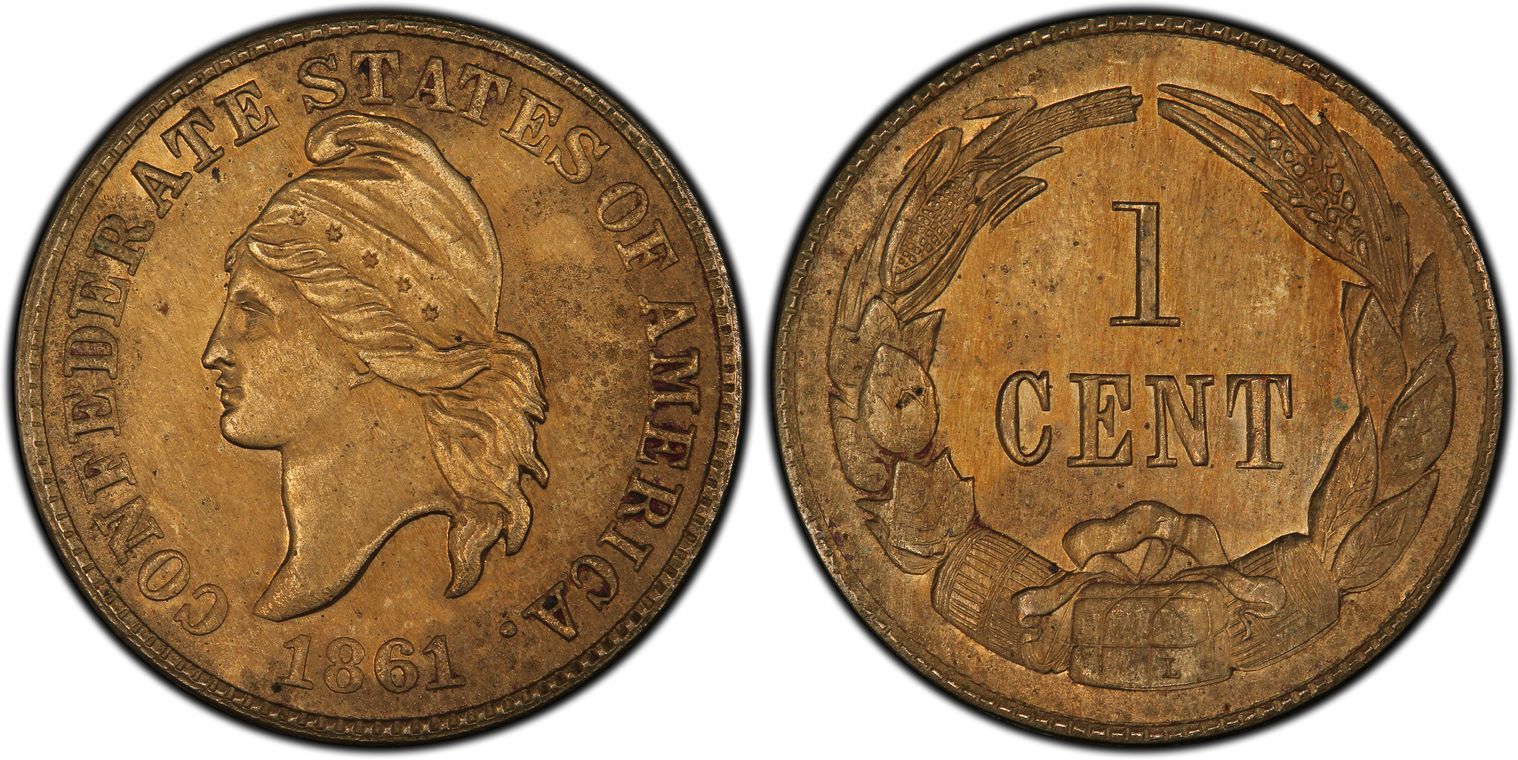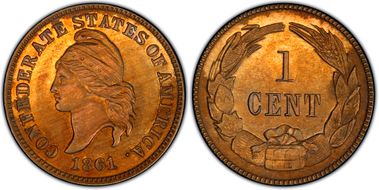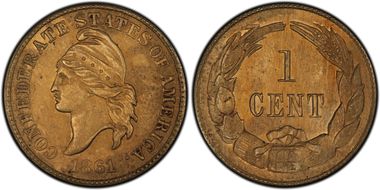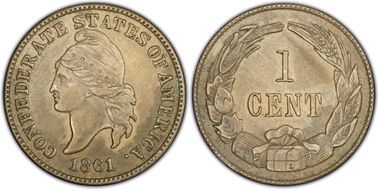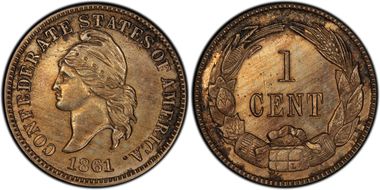- PCGS #:
- 340404
- Designer:
- N/A
- Edge:
- N/A
- Diameter:
- N/A
- Weight:
- N/A
- Mintage:
- N/A
- Mint:
- Philadelphia
- Metal:
- Copper-Nickel
- Auction Record:
- $211,500 • PR63 • 01-08-2014 • Heritage Auctions
Major Varieties
- 1861 1C CSA Original
Go To Grade
Current Auctions - PCGS Graded
Current Auctions - NGC Graded
For Sale Now at Collectors Corner - PCGS Graded
For Sale Now at Collectors Corner - NGC Graded
Condition Census What Is This?
P. Scott Rubin:
The Original Confederate Cent struck in copper-nickel is one of the most mysterious issues in numismatics. The coin was made by a well known Philadelphia die maker Robert Lovett, Jr., he was a second generation die maker who had two younger brothers who were also die makers.
The mystery starts with the question did the Confederate States of America hire Lovett to make the one cent coin. If the answer is yes, then was Lovett worried that he could be seen as working for an enemy of his country. If he was worried about exposure for the act why use an obverse design that was well associated with him, since he had used the same female head punch on his own store card dated 1860, and why put his last name initial “L” on the reverse die.
Whatever happened in 1861 to cause these coins to be created and struck by Lovett it appears that they were never turned over to the Confederacy? The next mystery is why were they not sent south. The answer to that may lay in the dies and coins themselves. It seems that of the fourteen or fifteen known specimens, maybe half or more show an ever growing die break on the reverse die, most obvious on the lowest leaf to the right and continuing up the next two outside leaves of the reverse with usage.
From 1861 until January, 1874 the existence of the Confederate Cent was unknown to the public. In that month coin dealer John Haseltine, sold the first of this issue ever publicly sold. In that catalogue he mentions that coin collector Edward Maris was the owner of the coin and that Robert Lovett had made twelve of these coins and that Maris owned ten or twelve. To confuse the issue even more in the early 20th century Haseltine told a different story about how the coins came into his possession and gave different numbers of Restrikes struck in copper, silver and gold, of this issue, which he was involved with.
Today we know that there are more than 12 original Confederate Cents known. We know that the Restrikes were stuck from the Original dies but with less pressure, creating a visible difference between the Originals and Restikes best seen on the reverse die, the engravers initial “L” on the cotton bale is well defined on the Originals and weak on the bottom of the “L” on the Restikes. We know the reverse die broke when striking some of the Originals and before any of the Restikes were produced. We know that Original die for the Confederate Cent is in the collection of the Smithsonian Institution.
The mystery starts with the question did the Confederate States of America hire Lovett to make the one cent coin. If the answer is yes, then was Lovett worried that he could be seen as working for an enemy of his country. If he was worried about exposure for the act why use an obverse design that was well associated with him, since he had used the same female head punch on his own store card dated 1860, and why put his last name initial “L” on the reverse die.
Whatever happened in 1861 to cause these coins to be created and struck by Lovett it appears that they were never turned over to the Confederacy? The next mystery is why were they not sent south. The answer to that may lay in the dies and coins themselves. It seems that of the fourteen or fifteen known specimens, maybe half or more show an ever growing die break on the reverse die, most obvious on the lowest leaf to the right and continuing up the next two outside leaves of the reverse with usage.
From 1861 until January, 1874 the existence of the Confederate Cent was unknown to the public. In that month coin dealer John Haseltine, sold the first of this issue ever publicly sold. In that catalogue he mentions that coin collector Edward Maris was the owner of the coin and that Robert Lovett had made twelve of these coins and that Maris owned ten or twelve. To confuse the issue even more in the early 20th century Haseltine told a different story about how the coins came into his possession and gave different numbers of Restrikes struck in copper, silver and gold, of this issue, which he was involved with.
Today we know that there are more than 12 original Confederate Cents known. We know that the Restrikes were stuck from the Original dies but with less pressure, creating a visible difference between the Originals and Restikes best seen on the reverse die, the engravers initial “L” on the cotton bale is well defined on the Originals and weak on the bottom of the “L” on the Restikes. We know the reverse die broke when striking some of the Originals and before any of the Restikes were produced. We know that Original die for the Confederate Cent is in the collection of the Smithsonian Institution.


